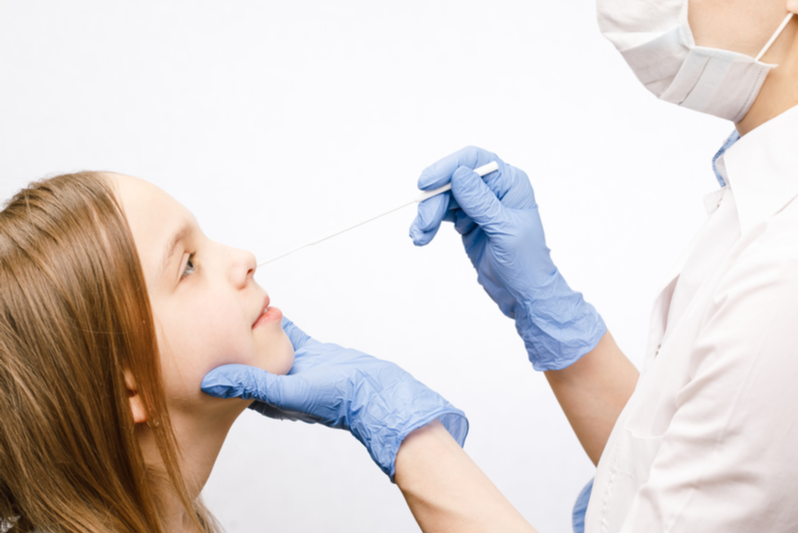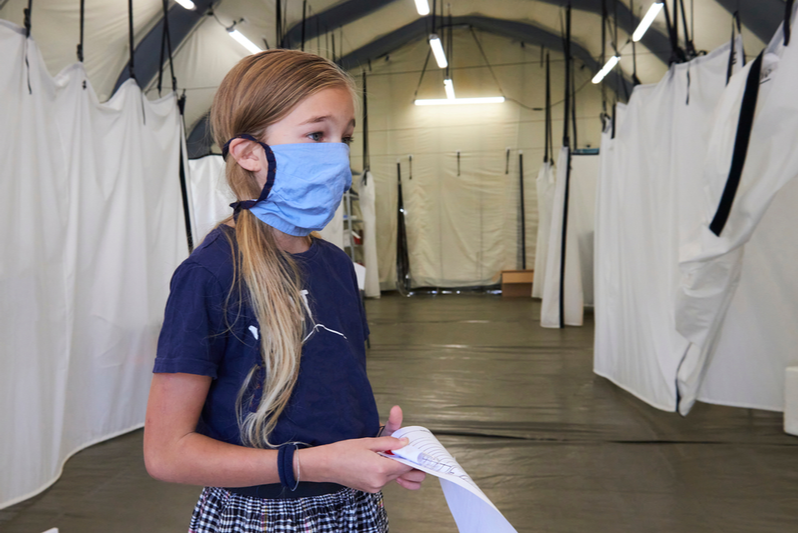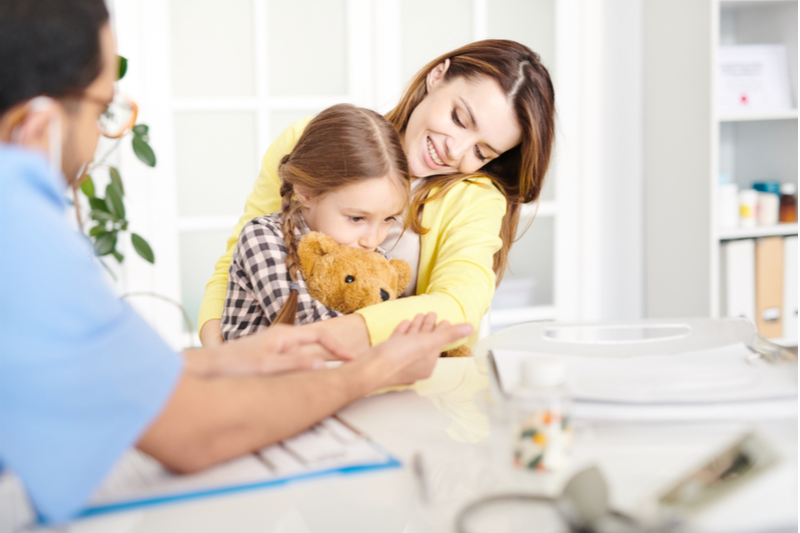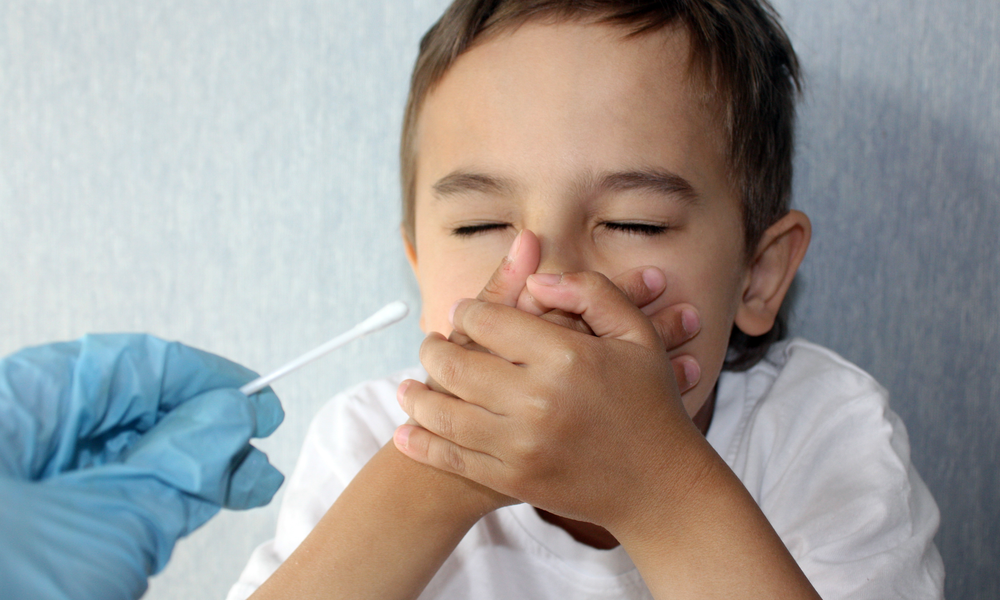Coronavirus testing is no fun for adults, and less so for children. But school-age children get lots of colds and fevers and may need to be symptom-free and test negative for COVID-19 before they can return to the classroom. That means having someone stick a cotton swab up their nose or down their little throats: not the most pleasant experience in the world. Parents can help prepare children for coronavirus testing by telling them the truth about the process; placing them in a comfortable position and showing them how to breathe during testing while distracting them from their discomfort, too.
If you go by the statistics, children are not as likely as adults to develop COVID-19. The over 657,000 young people below the age of 18 who have contracted the virus in the United States, represent just a little over 10 percent of the total number of coronavirus cases in America. Then again, children may not show symptoms of the virus, and may therefore miss out on getting tested. The best we can do is to test for coronavirus whenever kids get sick, even if it turns out to be just another cold.

Getting kids through any medical procedure is about minimizing their distress and keeping discomfort to a minimum. It’s scary to have a stranger stick things in your nose or throat, especially when the stranger is suited up in protective clothing. Coronavirus testing also hurts, if just a little bit for a short time. Here are some tips that can help make coronavirus testing a little easier:
Before You Go for Coronavirus Testing
1. Talk about the procedure.
Sometimes parents hide the truth from their children about an anticipated medical procedure. They think the truth may scare their children and make it difficult for them to cooperate. But telling your child what to expect is smart. When children don’t know what is going to happen to them, they use their imaginations to fill in. And what they imagine may be far scarier than what will actually happen, leading to a level of terror that might have been avoided.
It’s better to tell your child the details of what they can expect to happen, using simple language that suits the child’s age. More information, not less, is the way to lessen a child’s fear and help them feel more in control of the situation. Describe coronavirus testing to your child the way you’d tell a story. Talk about where you will go to have the testing; who will be there; what the child will see; how long the test will take; what will happen during coronavirus testing; and what the test might feel like.
Parents can also show children photos to help them understand what they might see. You might show your child photos of the testing site, the doctors and nurses, personal protective equipment (PPE), and coronavirus testing gear, to help familiarize and orient your child with the testing process.

Bring out a cotton swab to serve as a reference for what will happen: something she can see and touch. If your cotton swabs are different from the one used for the nasal swab, explain in detail how it differs, for instance, “The swab used for testing is like a Q-tip but on a longer stick. They’ll put the Q-tip in your nose, wiggle it around a bit, and then take it out. After we go home, they take the Q-tip and look at it under a microscope to check for coronavirus germs.”
Tell the truth, be accurate, and say as much as you know, using neutral language. When you talk to your child about how coronavirus testing might feel, keep it simple. “Some kids say it’s a weird feeling like soda pop bubbles getting in your nose and it hurt them just a little for a second. Other kids say it doesn’t bother them at all.”
Watching videos together about coronavirus testing also helps prepare children for the experience. Encourage your child to ask any questions she might have. Here are a few good videos on to choose from:
2. Plan out your coronavirus-testing coping strategies
It’s good to develop a plan for coping techniques you and your child can use before, during, and after coronavirus testing. Having a plan at the ready prevents children from feeling nervous. Let the children help you plan, and have children practice these strategies at home before the big day.
A good coping strategy for before the test may be something as simple as asking your child to tell you when she’s feeling worried about the upcoming test. The two of you can then practice taking deep, calming breaths at home together, while listening to soft music. If your child enjoys drawing, have her draw a picture of what she thinks coronavirus testing will be like. Drawing is a great way for a child to work out feelings about new experiences. Have your child tell you all about her drawing. Display the picture where everyone can see it.
During the test, it’s good for children to have a task to focus on. The task may be something as simple as sitting as still as they possibly can, holding a parent’s hand tightly, or hugging a beloved teddy bear. In advance of the testing day, suggest some ideas and let your child help choose what task they will take on during testing.
3. Be prepared to distract your child during the long wait for testing
Coronavirus testing may mean a long wait in line, in your car or on foot. The waiting may be frustrating or boring for your child, and may increase the child’s fear about the upcoming test. Be ready with games, music, stories, jokes, and maybe a video or two on your phone. Bring earphones.

During the test
4. Figure out who goes first
If several family members are to be tested, have a parent or the least worried child go first to serve as an example. A parent can model good coping strategies, and also demonstrate that the test is quick and easy.
5. Position your child for comfort
Position your child so that she feels secure and safe during the corona-testing procedure. If the testing takes place at a drive-through location, sit next to your child in the car and wrap your arms around her. At a testing center, the child can sit on your lap facing sideways or with the child’s back facing your chest. Hold the child close in your arms like a hug. Some children like to be wrapped in a blanket first, before being held in this “hug.” You can practice this at home and see what your child likes best.
Some children may need a parent’s help to hold their forehead to keep still during the nasal swab. For an older child, it’s probably enough for you to place your hand on the child’s shoulder or leg as a means of providing contact and comfort during the swab.

5. Act as your child’s coach
Talk your child through the procedure. Have the child take deep breaths through the mouth during the swab and suggest that she might like closing her eyes. Tell her you’re going to count out loud to 20. This gives her something to think about other than the swab and also gives her a sense of how long the procedure will take.
After the coronavirus testing
6. Talk about what went right
Coronavirus testing can be scary for children, and it helps to process the experience by talking about it after the fact. On the way home, praise your child for doing the best she could during a difficult situation. You might say, “You did so good taking those deep, calming breaths. I was impressed.”
Ask your child how well she thinks she coped on a scale of 1-10; what she thinks she did especially well; and where she might have done better. Children sometimes fear that taking a coronavirus test means they actually have COVID-19. Reassure your child that a negative result is more likely, but that the answer will come within a few days. Let your child know that you are there to support and help her during the wait for results.
It may be helpful for you to create a short video of the two of you reviewing your child’s coronavirus-testing encounter. A video is a good thing to have for future reference. Your child may like to watch the video from time to time to remember, and process the coronavirus testing experience.

This pandemic may last for some time. That means your child may have to have coronavirus testing on more than one occasion. Reviewing the coronavirus testing experience can help to prepare your child for the possibility of further coronavirus testing in the future. Emphasizing the more positive aspects of this round of coronavirus testing can only help to lay the groundwork for a better experience the next time around.

Ms Epstein – your advice sounds almost like my mother’s – she too had a lot of experience with youngsters – I’m one of eleven. I’m commenting on two points and my second is more important.
1 – You are absolutely right, as a physician I try to explain in layman’s terms everything I’m doing and ask if my patient is getting “too much information”. They need to be invested in the process of care but don’t need to be annoyed unnecessarily. The swab in the nose is unpleasant – but unbelievably, it doesn’t actually hurt – not like a bee sting or a door slammed on a finger hurt!
2 – I have modified my home for SARS-CoV-2 presence. Not that I hope to bring it home, but just in case. I have an ultraviolet light (dangerous – don’t look at it or get near it when energized) mounted in my HVAC system – your technicians can install one and I can’t promise no price gouging. Whether HEPA filtered or not, the UV-C light disrupts the SARS-CoV-2 RNA structure so any air circulated through is 99.999% disinfected. Or thereabouts…I also have two air ‘purifiers’, big filters with activated carbon that only filter down to 0.3 micron. The smaller of the two has UV-C built in, if anyone in my family tests positive it will go straight to their room. The big one is in the central location of the house, no UV-C but excellent odor and “fomite” control. “Fomites” are the particles that fall to the floor – you see them dancing in the sunbeams on occasion.
But great job for children & Covid testing. Be prepared – keep the house properly humidified, stay on top of your friends & children’s friends health, and be prepared! Wash hands often, disinfect doorknobs, and wear a mask whenever out in public!
Thank you for your comments, Dr. Pool. The ultraviolet light sounds interesting! I will definitely be looking into that. Glad you were satisfied with the way I covered this topic. 🙂